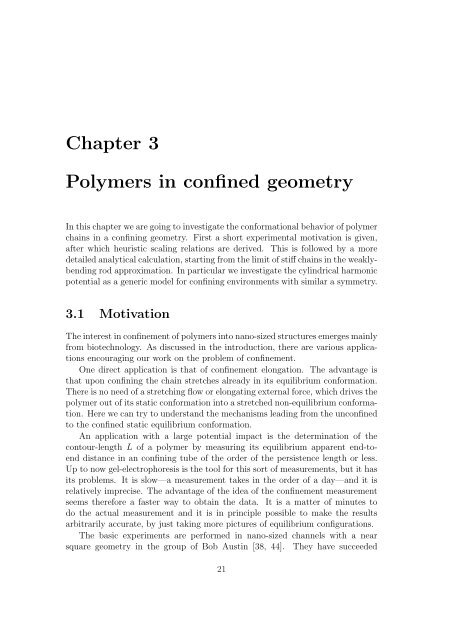Polymers in Confined Geometry.pdf
Polymers in Confined Geometry.pdf
Polymers in Confined Geometry.pdf
You also want an ePaper? Increase the reach of your titles
YUMPU automatically turns print PDFs into web optimized ePapers that Google loves.
Chapter 3<br />
<strong>Polymers</strong> <strong>in</strong> conf<strong>in</strong>ed geometry<br />
In this chapter we are go<strong>in</strong>g to <strong>in</strong>vestigate the conformational behavior of polymer<br />
cha<strong>in</strong>s <strong>in</strong> a conf<strong>in</strong><strong>in</strong>g geometry. First a short experimental motivation is given,<br />
after which heuristic scal<strong>in</strong>g relations are derived. This is followed by a more<br />
detailed analytical calculation, start<strong>in</strong>g from the limit of stiff cha<strong>in</strong>s <strong>in</strong> the weaklybend<strong>in</strong>g<br />
rod approximation. In particular we <strong>in</strong>vestigate the cyl<strong>in</strong>drical harmonic<br />
potential as a generic model for conf<strong>in</strong><strong>in</strong>g environments with similar a symmetry.<br />
3.1 Motivation<br />
The <strong>in</strong>terest <strong>in</strong> conf<strong>in</strong>ement of polymers <strong>in</strong>to nano-sized structures emerges ma<strong>in</strong>ly<br />
from biotechnology. As discussed <strong>in</strong> the <strong>in</strong>troduction, there are various applications<br />
encourag<strong>in</strong>g our work on the problem of conf<strong>in</strong>ement.<br />
One direct application is that of conf<strong>in</strong>ement elongation. The advantage is<br />
that upon conf<strong>in</strong><strong>in</strong>g the cha<strong>in</strong> stretches already <strong>in</strong> its equilibrium conformation.<br />
There is no need of a stretch<strong>in</strong>g flow or elongat<strong>in</strong>g external force, which drives the<br />
polymer out of its static conformation <strong>in</strong>to a stretched non-equilibrium conformation.<br />
Here we can try to understand the mechanisms lead<strong>in</strong>g from the unconf<strong>in</strong>ed<br />
to the conf<strong>in</strong>ed static equilibrium conformation.<br />
An application with a large potential impact is the determ<strong>in</strong>ation of the<br />
contour-length L of a polymer by measur<strong>in</strong>g its equilibrium apparent end-toend<br />
distance <strong>in</strong> an conf<strong>in</strong><strong>in</strong>g tube of the order of the persistence length or less.<br />
Up to now gel-electrophoresis is the tool for this sort of measurements, but it has<br />
its problems. It is slow—a measurement takes <strong>in</strong> the order of a day—and it is<br />
relatively imprecise. The advantage of the idea of the conf<strong>in</strong>ement measurement<br />
seems therefore a faster way to obta<strong>in</strong> the data. It is a matter of m<strong>in</strong>utes to<br />
do the actual measurement and it is <strong>in</strong> pr<strong>in</strong>ciple possible to make the results<br />
arbitrarily accurate, by just tak<strong>in</strong>g more pictures of equilibrium configurations.<br />
The basic experiments are performed <strong>in</strong> nano-sized channels with a near<br />
square geometry <strong>in</strong> the group of Bob Aust<strong>in</strong> [38, 44]. They have succeeded<br />
21













